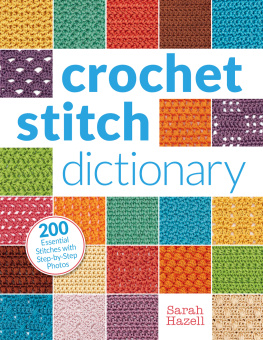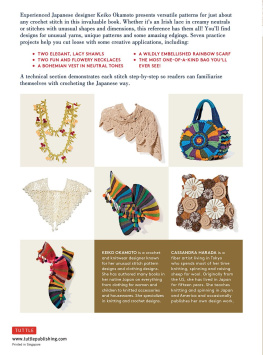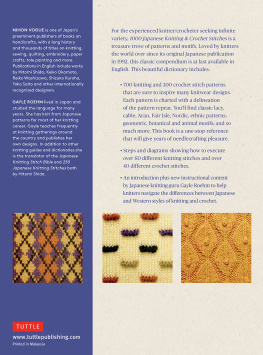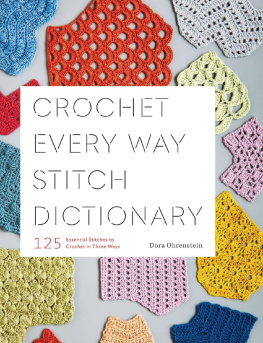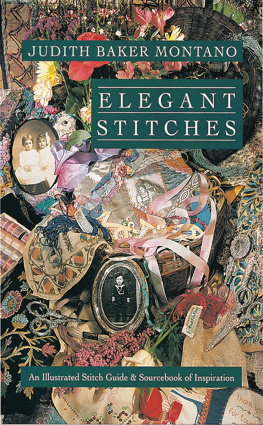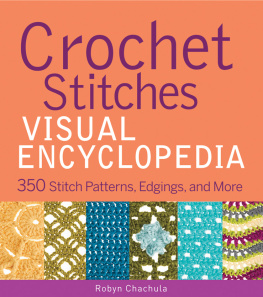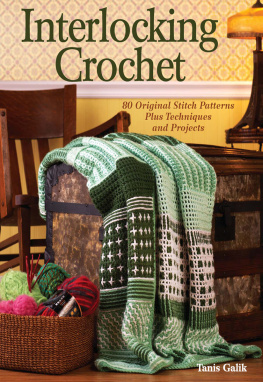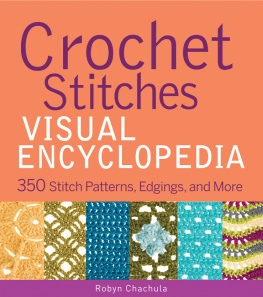crochet
stitch
dictionary
200
Essential
Stitches with
Step-by-Step
Photos
Sarah Hazell

Foreword
As a fanatical knitter, I never thought I would be able to master the craft and skill of crochet. Recognizing my passion for color and yarn, a colleague encouraged me to have a go, and I was hooked! While this may be a rather overused pun, it goes some way to convey how addictive crochet can become. The rhythm and repetition of stitches and patterns is not only soothing and relaxing, but encourages you to test out different combinations. After all, if it goes wrong or you dont like something, a row or round is easily pulled out without disturbing all your other hard work.
Crochet is a highly creative process. Stitches can be made taller, shorter, wider, narrower, textured, or smooth using some very simple techniques. Introduce color into the equation and you will soon discover some beautiful, graphic patterns.
The purpose of this book is to make all of these techniques accessible to you. I have taught crochet at workshops for many years and have found that it is useful to have lots of visual references as well as written instructions. I hope that the step-by-step photos and charts will help you to navigate your way through each stitch. The book is divided into different sections, and I have tried to build an element of progression into each section. I have also indicated which yarns and projects may work with certain stitches. These are suggestions only and I hope that you will see the book as a resource for extending your skills and developing your own ideas.

Sarah Hazell
About This Book
The book begins with Getting Started () and start learning to work a huge variety of crochet stitches.
- For most of the stitches in this book, the step number is the same as the row number it describes. Where this is not the case (if there is a base row, a step includes instructions for more than one row, or instructions for one row are split over more than one step), the row number(s) will appear in curved brackets after the step number.
- Advanced or specialist stitches are explained with clear written instructions in a Special Stitch section when they are needed.
- Where the stitch is worked from the wrong side, this is indicated at the start of the instructions and by an arrow on the chart.
Directory of Stitches
Two hundred crochet stitches make up the stitch directory with written instructions and charts to help you to master a wide range of crochet skills. Organized into nine families of stitches and clearly numbered, you can dip in and out of the directory or work your way through a particular section to develop your skills in that area.

- Stitches are clearly numbered and divided into stitch families, which are indicated here.
- Symbol charts in the color of the swatch provide a visual map for working the stitch. Symbols indicate the different stitches and how they are placed in relation to each other. A full list of symbols can be found on . Charts show at least one full pattern repeat and represent the right side of the work. Right-side rows are numbered at the right and read from right to left. Wrong-side rows are numbered at the left and read from left to right.
- Swatches provide a great visual for how the finished stitch will look.
- Clear step-by-step photographs show you how the stitch progresses and what your work should look like at certain points.
- The final step of each stitch indicates which steps should be repeated to continue building the pattern.
- Asterisks * within the instructions indicate a point from which instructions are repeated. For example, Rep from * to end means you should repeat the instructions after the * to the end of the row. Where instructions given after the * do not fit exactly or a different stitch is worked at the end of a row, the instruction will reflect this. For example, *1dc in next dc, 2tr in next dc, rep from * ending 1tr in last dc means repeat the instructions after the * but at the end of the last repeat, work only 1 treble into the last double crochet.
- Square brackets [ ] tell you to read the enclosed instructions as a group. For example, skip [1dc, 1tr] means that you should skip 1 double crochet and skip 1 treble. Similarly, [2tr in next tr, ch1] twice indicates that you should work 2 trebles in the next treble, chain 1, 2 trebles in the following treble, chain 1.
- Written step-by-step instructions guide you through the creation of the stitch. Make sure that you begin with the correct number of foundation chains and follow the instructions exactly. The terminology of crochet can be confusing at first. A full list of abbreviations is given on at the back of the book.
- The charts for some stitches are broken down to help you locate the specific part of the chart that relates to the instructions in that step or steps. Previous steps/rows are faintly shown so you can see how the chart and the stitch builds up.
- Curved brackets ( ) are used within the instructions for explanation or additional information. For example: 1tr in next tr (center of 5) or Ch1 (counts as 1dc).
- Guidelines for the length of foundation chain required are listed. See for more on this.
- Different colored yarns are allocated a letter.
Getting started

From learning about hook sizes to taking care of finshed pieces, this chapter will walk you through the essentials of crocheting. Basic stitches and useful techniques are covered with step-by-step instructions and illustrated with clear line drawings, so you can develop your skills and become a confident crocheter.
Equipment and Materials
The hooks
Crochet hooks may be made from aluminum, steel, wood, bamboo, or plastic. They are available in a variety of sizes to suit different types of yarn and gauge requirements (see ). Sizes range from 0.6 mm (the smallest) up to 15 mm or more, and the hooks are normally between 5 inches (125 mm) and 8 inches (200 mm) long. The shaft behind the hook may be cylindrical, or with a flattened area to help you hold it at the correct angle. Try out the different options to decide which suits you best.

Hook sizes
The internationally used metric system of sizing known as the International Standard Range (ISR) gives the diameter of the hook shaft in millimeters. Before metric sizing, crochet hooks were sized in two ranges: steel hooks (small sizes for fine work) and aluminum or plastic hooks (larger sizes, sometimes called wool hooks). U.S. sizes were used in America and Imperial sizes in the U.K. and Canada, and it is useful to understand these: you may have old hooks in your collection, or wish to follow an old crochet pattern.

